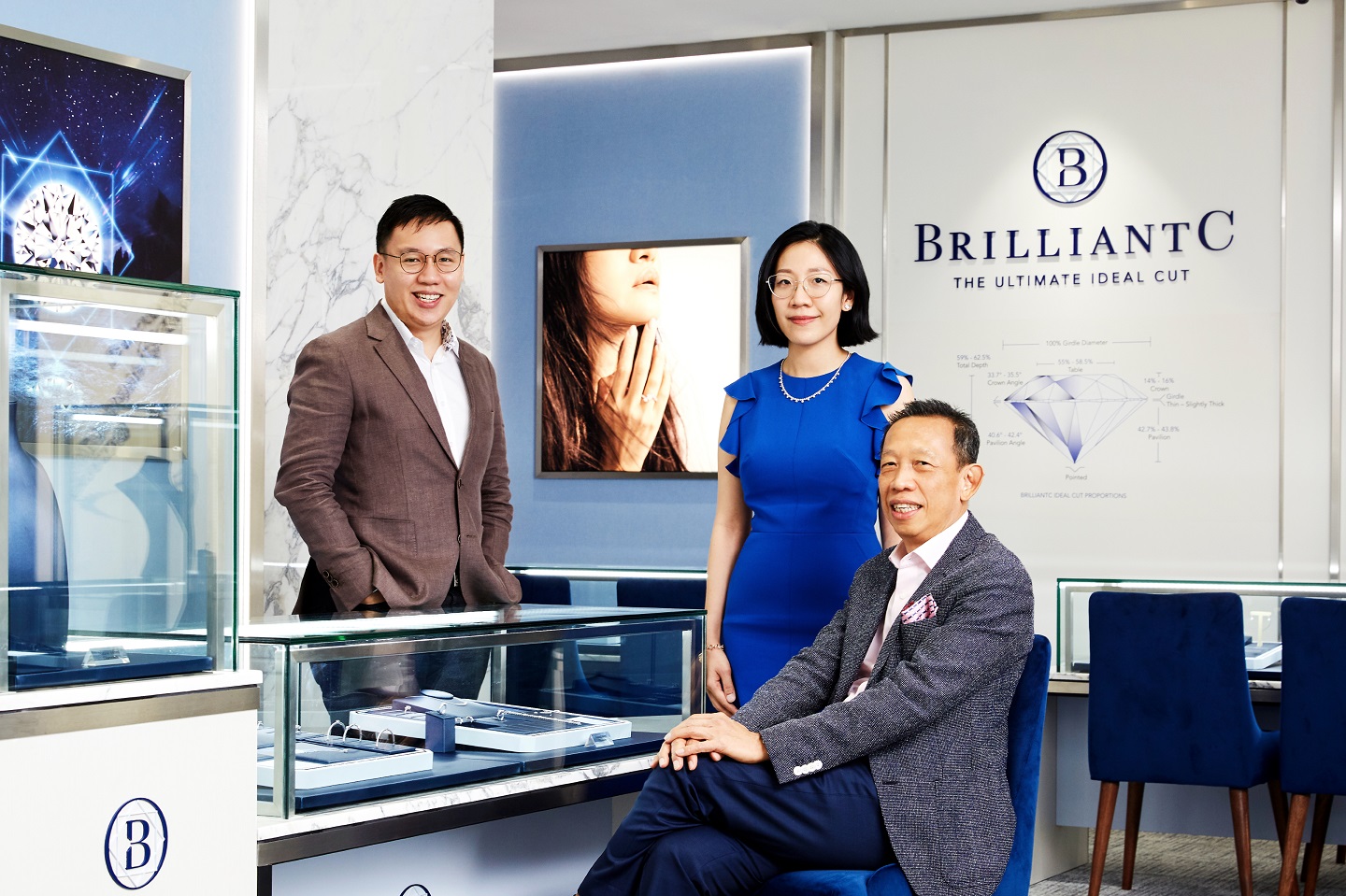
Stephen (sitting) with his nephew JC and daughter Jiayueh (Photo: Soophye)
Behind every diamond bought or given to celebrate an occasion is a story. Before gems find their place on a ring, pendant, bracelet or necklace, there are stories about where they were mined or sourced, how they were designed, cut and mounted and, of course, the moment a woman slips one on her finger or hooks a string of them around her neck.
“There are so many stories to tell about jewellery,” says DeGem Group CEO Stephen Choong, who does that as he brings out prized pieces one at a time. Few can claim to have his breadth of experience — evident from the compelling snippets he shares about the industry — and fewer still have that sparkle in their voice when talking about diamonds and gemstones.
With Stephen at the company’s flagship boutique in Bangsar Baru, Kuala Lumpur, are his nephew Choong Jia Chen (aka JC), DeGem’s operations and business development director, and daughter Choong Jiayueh, the communications and design director. All three have their own stories to share about how they came into the business and why they are smitten by its allure.
In the olden days, Stephen remembers, people used to put their trust in jewellers on a par with banking institutions, as they were willing to place their money and jewellery with them for safekeeping.
He decided to part ways with books early in life — “I didn’t do well in my studies” — and focus on a career. Fascinated by the gemstones on his pawnshop broker father’s desk, and influenced by the family’s goldsmith heritage, he had little difficulty deciding what he wanted to do. Today, Stephen and four of his five brothers are at the helm of the DeGem group, which comprises DeGem, Diamond & Platinum, and manufacturing and wholesale supply services.
_s1a3654.jpg
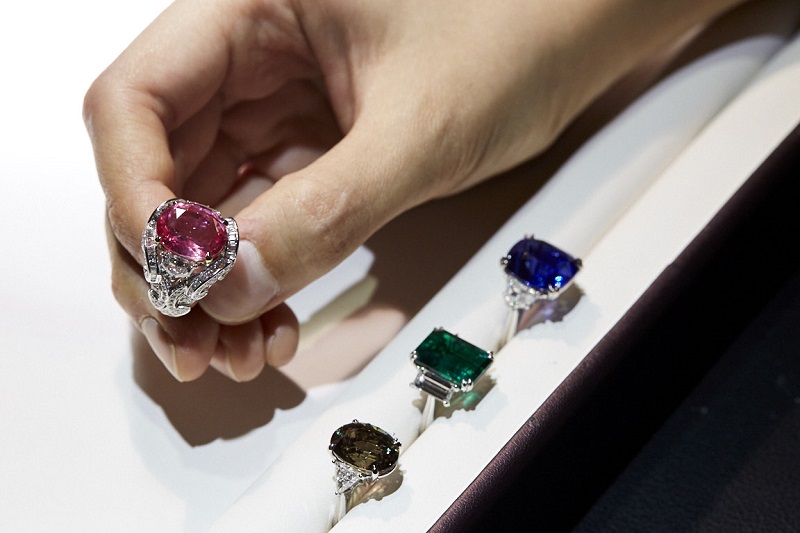
The business has changed since he started, from how things work to what customers want, and how old methods of crafting jewellery have given way to technology. The whole industry has changed more drastically in the last 30 years than the preceding 100 years, he observes. “It is very different from before. If some jeweller comes and tells you, ‘We hand-make everything’, I would say he’s 30 years behind time.”
Old stories about diamonds being hand-cut in Antwerp and New York are a thing of the past too. “They lack the scale, capacity and the manpower.” India, which has invested in all the machinery and technology, cuts 95 of the 100 stones found today. They are much more advanced and sophisticated than the rest, contrary to misconceptions.
“Before, you talked about jewellers using their hands and very traditional skills. Now, computers and machinery have come into the design and manufacturing of jewellery. It’s a revolution — for the better.”
DeGem, which started in 1980 as a custom design jeweller, has also scaled up over the decades. It combines the best of both worlds — state-of-the-art technology and handcrafting and artisanal skills maintained over half a century, to achieve technical mastery and design advancements. This exacting approach has helped it build a reputation for refined artistry and scientific precision, with products rivalling those of international brands.
The company has four brands — BrilliantC (the ultimate ideal cut diamond), Infinity (wedding bands), Soleluna (contemporary fashion jewellery) and De Beers Forevermark Diamonds (it is the label’s authorised licensed distributor in Malaysia).
During the 2020 awards season, Hollywood celebrities such as Awkwafina, Idina Menzel, Reese Witherspoon and Janelle Monae walked the red carpet dressed in DeGem jewellery.
Stephen has followed the flow of change too and obviously enjoys the ride. “Interest is the biggest motivation. If you don’t have the passion, I don’t think you can survive in this business. It’s very hands-on, from sourcing the stones to manufacturing the pieces and managing people. There are long hours — you know, the servicing business.”
awkwafina_golden_globe.jpg

He goes on yearly trips to buy top-grade diamonds and gemstones and deciding what to pick from the array set before him is an experience in itself — and a story that evokes laughter, the way he shares it.
“Sometimes when you look at a stone, you take some time to consider. When you go back to the hotel, all these images keep haunting you, telling you, ‘Bring me home!’
“When we went into collecting stones ourselves, it was a kind of sentimental [decision]. Then, we found we could turn a hobby into business and business into a hobby. That’s why a jeweller can never retire. Once you get into it, it’s quite difficult to part from it because of personal interest. We can slowly fade away. But if you ask us to stop, we cannot.”
Jiayueh remembers following her father on buying trips while growing up. “Most of our travels included work. My mum and sister would go shopping and he would take me to the gem traders’ offices. I didn’t know a lot about pricing, only which pieces looked good and which did not”.
But she did not think much about jewellery until after graduating in communications from the University of Melbourne and could not find a job in marketing. She tried retail instead and a bridal jewellery house gave her the opportunity to do a design and sales training programme.
“You know how Aussie customers are very chatty — they can tell you things about their whole family in minutes. Every time they came in for their complimentary ring-cleaning, I saw the value of doing jewellery. It was from customising wedding bands and rings that I came to know how jewellery is linked to happiness and all the happy occasions in people’s life. That’s where my interest really began.
“When my visa expired, my dad said, ‘Why don’t you try working for me?’ I said okay.” She quips that it could be because she had told him the retail business had offered her a job, so he did the same.
Stephen laughs at that but adds: “For us, nothing is really planned. It’s much more our own interest.”
degem.jpg
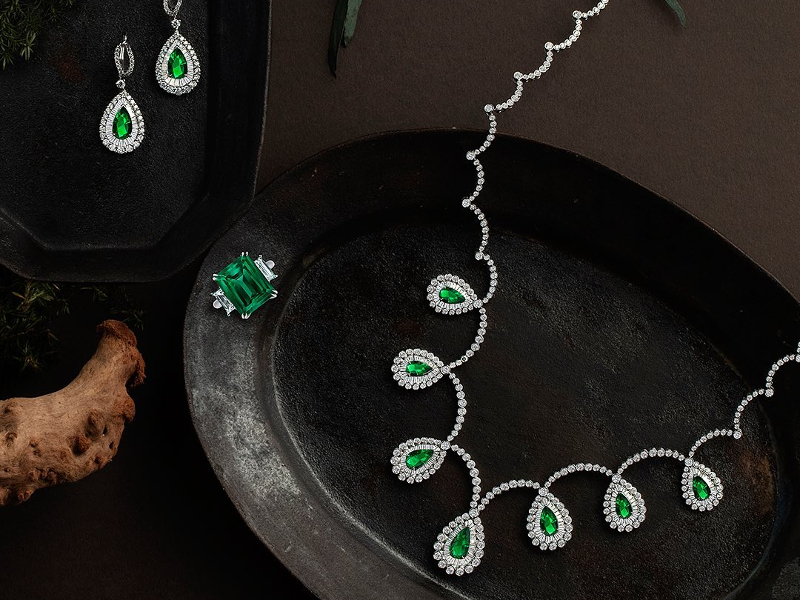
JC cut his teeth in the family factory as a teenager sorting gems. His father was managing business on the floor and often brought him in to help. “He would tell me, ‘These are similar colours. These can be a pair’. Brought up in that kind of environment, my interest started.”
He graduated in accounting and finance but did not take a shine to what he was doing. Gemstones proved the stronger attraction, so JC studied gemology in Bangkok and stayed in the city for eight years, setting up and working in cutting factories. Passionate about sourcing for gemstones direct from mines and cutting roughs, he created DeGem’s upstream and lapidary operations and now oversees sales as well.
The young pair came on board officially early in 2020, to spearhead an omnichannel strategy directed at the younger generation of consumers, who tend to do research online before stepping into DeGem’s boutiques to buy what they have set their eyes and
heart on.
When Covid-19 started two years ago and impacted the economy and physical movement, the management was concerned because jewellery is not an essential product. But things took a positive turn and business was better than anyone expected.
The pandemic changed the mindset of the young who used to visit foreign countries for luxurious experiences. When travel was curbed, people could not meet, which meant no big weddings or celebrations. With extra cash on hand, they were more willing to invest in a better quality diamond ring for their engagement and nuptials.
“We expected the worst but, to our surprise, survived 2020 well and grew stronger in 2021,” JC says. There was strong demand for rare diamonds and gemstones such as ruby, jadeite and even rarer gems such as paraiba tourmaline, spinel, tsavorite garnet and untreated Padparadscha sapphire.
There were increased and consistent enquiries for engagement and wedding rings and jewellery gifts to mark special milestones, Jiayueh adds. “Commitment of love endures during hard times and bridal jewellery was deemed a necessity for registrations, micro weddings and proposals. The pandemic strengthened the consumer’s desire to invest in and hold value.”
The younger generation is buying jewellery for themselves, and through the lockdowns, they were at ease using DeGem’s online channels to ask about stones, colours, prices and personalising designs. Customers, many of whom lived outside of the Klang Valley, connected with consultants over the phone or via social media to learn more before finalising a purchase either online or in-store.
Consumer focus and thinking have changed, as well as spending habits, but there is still large untapped potential in the local market, the cousins note. Luxury purchases are not all about the hype of revenge spending. Instead, they show that people are more cautious about what they buy and mindful of what builds future value.
People tend to think that diamonds are easy to match with their outfits and go for that, Jiayueh says. But once they have a collection, they will begin to be curious about gemstones. “We will advise them that natural and precious gemstones are more unique and the value keeps getting better over the years.”
If people want jewellery purely to make a fashion statement, they wouldn’t be buying diamonds or gemstones, JC adds. “But if they want to keep it in the family for the next generation, and want something durable and of value, then these would be it.”
Stephen chips in: “Generally, we say apart from the sentimental value of jewellery, there is the price value.” Tradition enhances the latter — you know something is going to be worth more after some time if you can hold on to it.
He knows of an old, prominent family that is still holding on to huge pieces of jewellery left by their ancestor. “The workmanship — these pieces are over 100 years old, 100% handcrafted — makes them works of art. It’s a sin if you break them up for resetting or other purposes. They cannot be replaced anymore.”
Rarity determines the value of a diamond, apart from its beauty. When there is not enough supply to meet demand, prices appreciate. There are a few mines in the world where the gemstones have been depleted. Kashmir sapphires, for example, are not being mined in the country anymore. What there is in the market are old pieces that are being recycled, Stephen says.
‘A similar thing has happened to Burmese rubies; now that they are close to depletion, you almost do not stumble upon any freshly mined pieces. In the past decade, Mozambique rubies became a sensible alternative and reasonably priced source, with its mining starting around 2008. But now as demand outweighs Mozambique ruby production, their prices have soared too,” explains JC.
_s1a3665.jpg
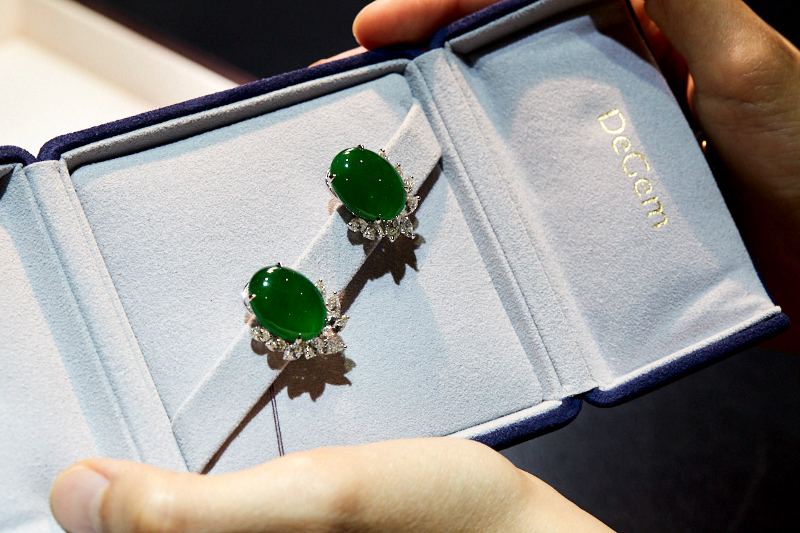
Miners need to unearth one tonne of earth to get one carat of diamond rough, from which jewellers can use only 30% to 40% of the rough for the final polished diamond — that’s how rare natural diamonds are, says JC. “Whenever I visit a mine, I am always alert to things that shine on the ground because I expect to pick up some rare gemstones! So far, I’ve not been lucky to find one.”
But he is excited about the company partnering a world-renowned diamond cutter to wholly source natural diamonds from conflict-free mines and cut them following DeGem’s formula that yields maximum diamond light performance.
“Before, we graded a diamond’s brilliancy based on cut, polish and symmetry. Now there is scientific grading technology patented by the American Gem Society Laboratories that can tell how light actually travels within the diamond, and how much sparkle is reflected when light goes through the diamond. We can precisely measure the diamond’s light performance three-dimensionally.”
DeGem’s BrilliantC diamond scores first-class grades using this new technology. It demonstrates incomparable light performance evident to the novice eye no matter what colour, clarity and carat weight. “It is our answer for individuals searching for the ultimate diamond jewellery that leaves an indelible impression, and a remarkable legacy.”
With sustainability close to its heart, the company is committed to ethical mining and social responsibility. There is also traceability, a key factor in selling diamonds nowadays.
BrilliantC is the first ideal cut diamond with traceable and transparent origins. Buyers can access their own diamond time-lapse traceability report to see where it was mined, how it was fashioned from its rough, architected, then cut to stringent proportions and precision and, finally, set into bespoke jewellery, JC explains.
Apart from the two cousins, there are a few more third-generation Choongs in the business, in accounting. Back end or front, Stephen emphasises, a dedicated team — from design to production, marketing and management — is crucial for the company to make unique jewellery that stands out from its competitors’, has consistent quality and is sustainably produced.
degem_dna.jpg
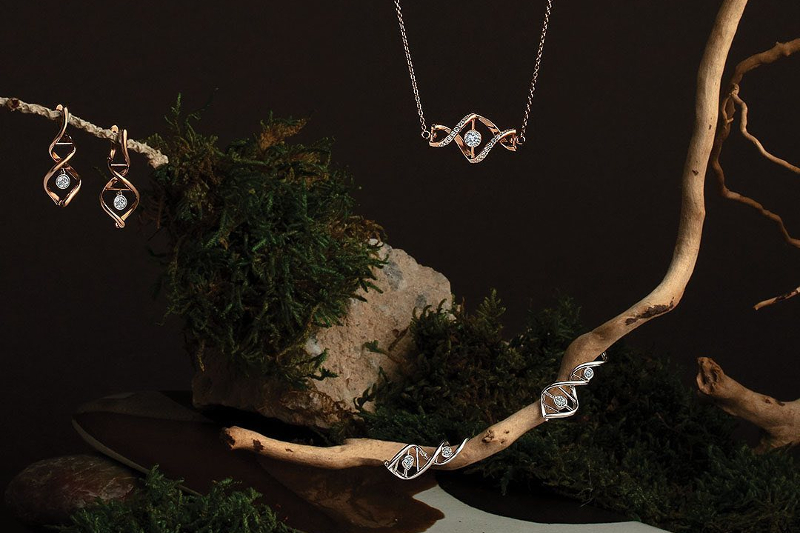
“All these skilled workers, they are very precious. It’s not easy to train them because of all the new technology used. You need the knowledge first, then you train them to be skilful. It takes a lot of teamwork as we have people in different capacities handling the jobs when it comes to making the products,” says JC.
After the designer has drawn an image of a product based on its concept, a 3D model is created on the computer, which the team pores over before proceeding to make a wax model. “Then we study the wax form to see if it’s user-friendly. If it isn’t, we go back and redo. If it is, we make the final product. But should we find it is not what we expect, we have to go back to the drawing board,” Jiayueh says.
The team examines every piece during the production process and fine-tunes new designs, paying close attention to delicate details like the way it is mounted, how each piece flows, its shape and structure, and user comfort especially.
“Jewellery is a tactile experience and our reward is when customers experience a DeGem jewellery piece and feel the difference in quality and standard,” says JC.
Producing everything under one roof gives them control over all the items that bear their name.
DeGem also offers ready-to-wear jewellery and haute joaillerie or made-to-order services. It launches new design collections every quarter for different ranges of products, and a grand collection every two years — the most recent being the DeGem DNA collection.
This science-meets-art collection reflects “beauty at 360 degrees” using a trademarked DeGem design inspired by a DNA double helix motif celebrating a person’s individuality. Brilliant cut diamonds picked to fit the curvature of each bracelet, ring or pendant are set precisely by hand. The pieces are created to swirl, spiral and pirouette with every move the wearer makes.
The launch of DeGem’s futuristic diamond jewellery points to where this third-generation brand is going, guided by the challenge of creating unique pieces that speak to every consumer.
Having nurtured a company that believes many skilled hands are necessary to make products with impeccable quality and value, retirement is not on Stephen’s mind, yet, although he is “planning towards that. We will fade out slowly lah, but still contribute in terms of using our experience of manufacturing and the connections we have to networks and resources, to run activities and grow the business.”
The wisdom of his years tells him there comes a stage when a person is less productive. “We have to change the roles and make sure things are properly handled.”
Jiayueh can understand why it is not easy to let go. “At the end of the day, this business is their first baby,” says this mother who had her first child last year.
Just as diamonds never lose their brilliance, one can imagine Stephen wistfully telling stories about this hardest substance on earth, with perhaps a sparkle in his eyes.
This article first appeared on May 9, 2022 in The Edge Malaysia.


